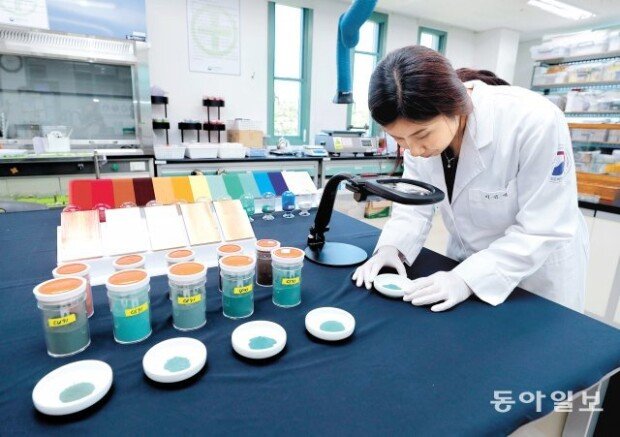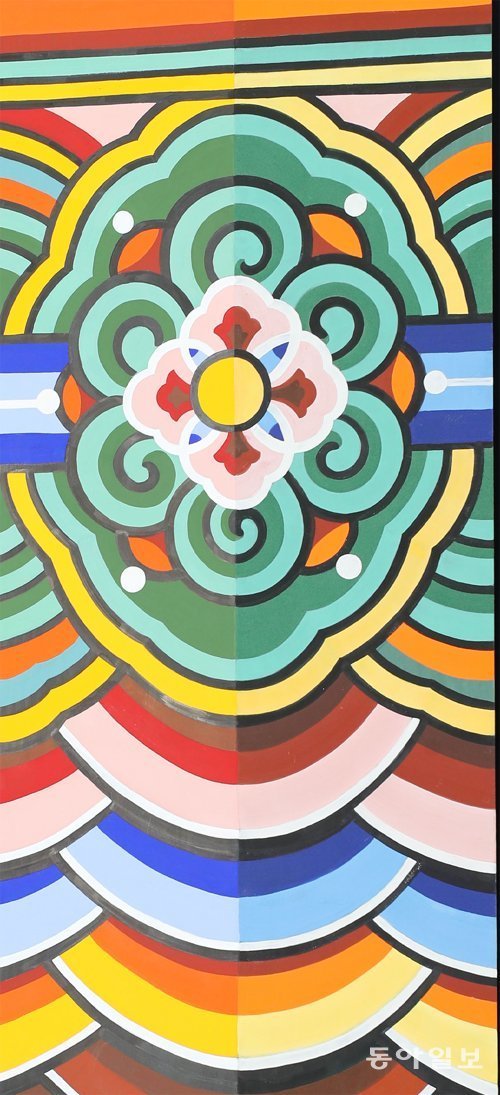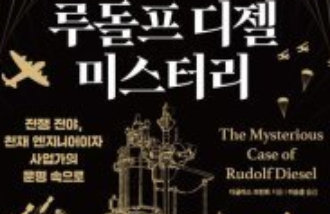Mystery unveiled: Secret of copper green rust of Dongrok
Mystery unveiled: Secret of copper green rust of Dongrok
Posted September. 09, 2022 07:29,
Updated September. 09, 2022 07:29


Dongrok, a traditional green pigment, is dubbed the lotus leaf for having a deep green. Used to decorate the Dancheong of many Korean traditional buildings such as the Daeungjeon Hall of Bulguksa Temple in Gyeongju, North Gyeongsang Province, and the Daeungbo-jeon Hall of Magok-sa Temple in Gongju, South Chungcheong Province, this green color of Dongrok became obsolete and rare around the time the modern era began in the late 19th century. As the chemical pigment market started growing, traditional paints lost ground with many artists hesitant to preserve traditional technics that require a high cost and a long process. Dongrok, as a result, had long been left mysterious even in China and Japan, which dominate the traditional pigment market across the eastern Asian region.
The National Research Institute of Cultural Heritage under the Cultural Heritage Administration made it to discover ways to restore Dongrok, the color which otherwise would have been lost forever. Starting from 2019, the research center studied historical references recorded in Korea, China and Japan to unveil the secret recipe for this magical pigment. Incredibly, the South Korean research crew unveiled the mystery of Dongrok earlier than China and Japan, the top two pigment producers. “It took four years to find out the secret to restoring Dongrok, which is only two lines long out of a pile of old documents of the three countries,” Lee Seon-myeong, a researcher from the National Research Institute of Cultural Heritage, said in the research institute’s restoration technology division in Daejeon on Wednesday.
One of the leading formulas for producing Dongrok is written in the medical classic “Sinsuboncho” in 659 during the Tang dynasty. According to the book, it takes copper powder, sodium chloride, ammonium chloride, etc. to create Dongrok. It has long been said that ancestors would use substances that come from corroded copper to produce green pigments, considering that the surface of a corroded copper bowl gets green and rusty. However, with only ingredients written in historical materials, not any further details on their exact proportions were known to researchers, leaving them curious about the secret of Dongrok.
“The research team tried several hundred times to make tweaks to the ratio of copper and corrosive chemicals such as sodium chloride and ammonium chloride as if it were unraveling mysteries,” said Kang Yeong-seok, another researcher at the restoration technology division. “Out two-year experiments have concluded that the best proportion of copper powder vs. corrosive chemicals is one to two.”
The hard-won green color of Dongrok differentiates from any chemical pigments. “Natural pigments ensure a grainy painted surface as if all the bumps were alive while a surface painted by chemical ones is only plain,” Lee said. “That is why we aspire to restore traditional pigments.”
The discovery of the perfect formula for Dongrok also opens the door to the restoration of the perfectly traditional Dancheong. The research institute did an analysis of substances of 668 green-painted parts in 44 traditional architectural heritages from 2017 to 2020, finding that Dongrok is applied to 226 samples of the places. Dongrok turned out to be more widely used than power-type green colors such as Seokrok (malachite) and Neorok (celadonite). The research institute plans to share the secret of Dongrok with Dancheong painting masters to help them have a heightened understanding of traditional pigments.
always99@donga.com







